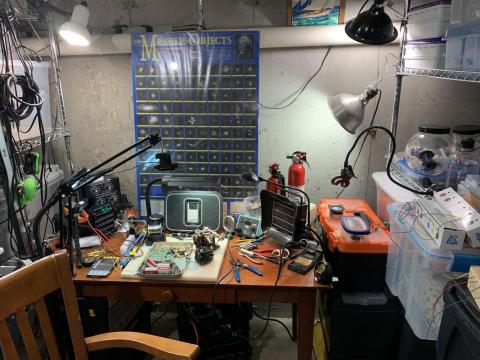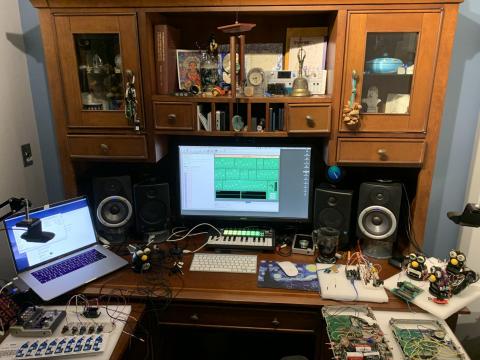Dr. B. Is in the House: Why Remote Connection Can Still Be Deep
Richard Boulanger—or Dr. B. as his students call him—is finding ways to encourage immersive learning, even while away from campus.
Image courtesy of the artist
It took some doing to schedule a time to talk with performer and composer Richard Boulanger, professor in the Electronic Production and Design Department, about his experiences teaching Berklee classes remotely because, as he said, he needed time to prep his space. Even though we’d only be talking over Zoom, I was soon to learn that what Boulanger—or Dr. B., as his students call him—considers prepared for class is what others might consider creating an art installation.

Considering the highly technical skills that Boulanger teaches his students—such as building a synthesizer, designing an effects processor, or circuit-bending vintage kids' toys into novel instruments—it’s clear why he puts so much work into being prepared. “I’ve got to be ready to do 10 things at a time,” he said, because the students’ unique projects are what shape the course, session to session.

Part of Boulanger's home studio is a circuit-bending area, which allows students to get an up-close view of some of the most technical parts of his courses.

Another of Boulanger's remote teaching work stations. Note the circuit-bent Furby toys on the right.

Dr. B. takes a selfie in front of part of his home performance space.
One thing that helped set his remote version of Circuit Bending and Physical Computing apart from its campus iteration, for example, is that Boulanger was able to find affordable circuit bending kits that each student can use in their workspace. This brings a new sense of ownership to the course because what the students create, they get to keep. What they lose in terms of access to well-stocked labs, they gain in practical application, which could result in a product they eventually bring to the wider music world.
“I’m teaching musicianship and humanity. And we’re all discovering this together.”
—Richard Boulanger
Boulanger is not just preparing for class, he’s preparing the students for their careers as musicians. He believes so much in what his students make that he saves every project created in his courses—a practice he began in 1986. His continued dedication yielded an increase in enrollment over the spring and summer; his summer course on the sound and music computing software Csound is filled with more students than ever. His success speaks to the fact that it takes more than having the right tech on hand and being comfortable on Zoom; it’s about his commitment to connecting with his students.
Finding the Human Behind the Screen
Matthew Nicholl, dean of the Professional Writing and Music Technology Division, said that the division’s faculty were finding ways to transcend the technology in order create an authentic space for student learning, even during a pandemic. “The tech needs to become transparent in order to create that space for students, so faculty can still mentor students and curate information and inspiration,” Nicholl said.
It feels like a slight exaggeration to say that talking to faces on a computer screen in your bedroom can lead to deep educational engagement. But as Nicholl suggested, the way to get there is through faculty, like Boulanger, who recognize the importance of human connection. At the core of his approach, Boulanger says, “I’m teaching musicianship and humanity. And we’re all discovering this together.” And, in fact, Boulanger told me that when the department’s assistant chair recently asked students how remote studies were going, one student responded with a different take on what it’s like learning from home, saying, “Are you kidding me? Dr. B’s in my house now!”




